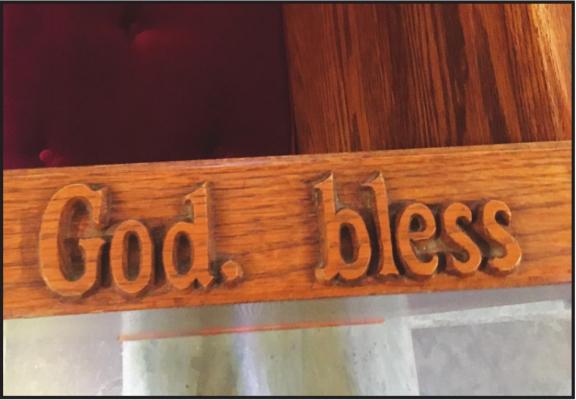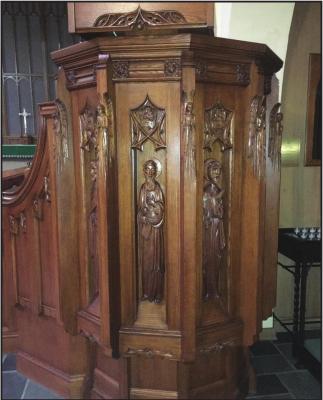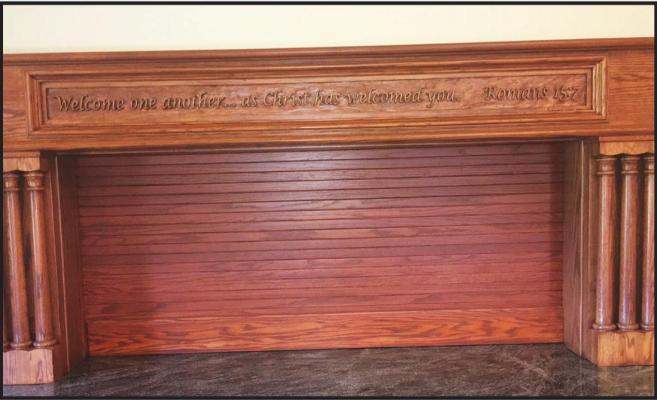Wood carvings at Grace Episocpal Church
Grace Episcopal Church, located on 109 North 13th Street, was dedicated on the Feast of Pentecost, 1952. The rector at the time, The Rev. Thomas Moehle, was instrumental in creating plans for many of the wood carvings that beautify our church. Here are two examples of his dedication to detail that we benefit from to this day:
THE PULPIT
The pulpit is where the Word of God is proclaimed and preached, so it is fitting that it is adorned with images of the Four Evangelists -- Matthew, Mark, Luke, and John.
They are seen here, carved in full relief, and set in recessed niches of the pulpit below their respective shields. Though the statues reflect Fr. Moehle’s original designs for the pulpit, the designs were not located until many years later, when they were finally completed by Italian artisans. The statues were then installed under the leadership of The Rev. Kenneth Armstrong, who was then the rector of Grace Episcopal Church.
SYMBOLISM:
St. Matthew — a winged man. This image points us to the centrality of the Incarnation to Matthew’s Gospel and to the truth that Christ was fully divine and fully human.
St. Mark — a winged lion.
The image of a lion is derived from the prophetic visions contained in the Book of Revelation, where it is one of the four living creatures described around the throne of the Almighty. The Lion of St. Mark is also the symbol of the city of Venice, for, as tradition has it, St. Mark once was traveling through Europe when he arrived at a lagoon in Venice, where an angel appeared to him and said “May Peace be with you, Mark, my Evangelist. Here your body will rest.” The remains of St. Mark are interred in the Basilica of St. Mark, which is accordingly located in the famous St. Mark’s Square of Venice.
St. Luke — a winged ox. St. Luke is symbolized by a winged ox or bull, a figure of sacrifice, service, and strength. Thus, the ox signifies the call of all Christians to imitate the sacrificial love of Christ revealed during his Passion.
St. John — a winged eagle. The eagle is a symbol of transcendence, flying high above that which we can easily see with our eyes. It is therefore a fitting symbol for St. John, for he was concerned with the highest contemplation of the mystery of Christ: the Word who was in the beginning with God and through whom all things were made who nevertheless is also the Word who was made Flesh and dwelt among us.
PEW ENDS
A single text flows across the pews of our nave, binding our very furniture to a silent hymn of praise. O all ye works of the Lord, bless ye the Lord; praise him and magnify him forever are its opening words.
It is the song traditionally ascribed to the three young men, Shadrach, Meshach and Abednego, who sang it as they were thrown into the fiery furnace for refusing to serve the gods or worship the golden image set up by Nebauchadnezzar, but who were untouched by the flames. Succeeding verses call upon all things in heaven and on earth and men to praise the Lord, before ending with its final petition, Let us bless the Father, and the Son and the Holy Ghost; praise him, and magnify him forever.
For Episcopalians, this hymn is appointed for use in the Office of Morning Prayer, whereby we start our days in thanksgiving for the works of creation that continually manifest the gracious providence of God, the maker of heaven and earth.
The typeface used on the pew ends is an adaptation of Cloister Old Style and was also designed by Father Moehle, who drafted each end on tracing paper for the woodcarvers. The chisel marks were left on the background as they produced a “more interesting effect” and are more in harmony with the lettering than a matched, perfectly smooth background. The manufacturer and wood carvers described the lettering as “Most beautiful and unusual.”
KITCHEN OPENING CARVING
Welcome one another…as Christ has welcomed you. — Romans 15:7.
This verse is appropriately placed over the opening to the kitchen from the Parish Hall, where parishioners gather after each church service.
In honor of Maxine Hunt, a long-time member of Grace Church, her son-in-law, Ernst Danielsson, skillfully carved this verse. Although he was a very successful plastic surgeon in Springfield, Missouri, he enjoyed wood carving in his spare time. He was from Iceland, where little boys often took up woodworking and carving. Being quite proficient at this art, he spent nine months planning his intricate carving of this verse.
The attractive frame and columns for this carving were completed by another parishioner, Cameron Fleming.




